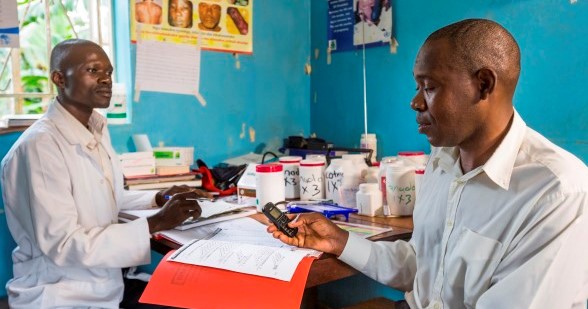Improved management of P. vivax malaria

What is this project?
This project takes a multifaceted approach to diagnostic solutions that are urgently needed for Plasmodium vivax malaria. It is enabling the development of future P. vivax tests by identifying serological (blood) markers that can indicate if a person has been infected with the parasite even if no clinical symptoms are present; informing WHO prequalification of new RDTs with improved sensitivity for both P. falciparum and P. vivax; and supporting the challenging implementation of a new “radical cure” drug that can eliminate P. vivax with a single dose.
Why are we working on it?
P. vivax represents the most frequent cause of malaria outside of Africa. Unlike most of the other malaria parasites, it can hide in the liver, lying dormant (in hypnozoite form) until it activates a relapse. This makes it a particularly challenging parasite to identify – and therefore eliminate.
RDTs that can be used for the rapid diagnosis of P. vivax infections are a key element of any disease elimination plan, and the cornerstone of diagnosis in primary care settings. Because P. vivax can also be hard to find even outside the liver – even more so in certain populations, such as pregnant women – the diagnostics for the job need to be especially sensitive. As part of our broader improved RDT project, we are supporting the development of a new RDT combination test to detect both P. falciparum and P. vivax, with 10 times more sensitivity than current tests. We are working with the developer to move this test swiftly through clinical performance evaluation, to accelerate patient access.
When P. vivax has been identified, that patient needs to be treated. A recently approved drug, tafenoquine, has been shown to be able to wipe out the parasite from the liver in a single dose. However, this “radical cure” can also cause life-threatening adverse events in patients who are deficient in an enzyme called G6PD. Ensuring that the drug is only given to people without G6PD deficiency is thus vital, and a suite of new tools that includes a G6PD deficiency diagnostic test and implementation models are needed.
What does it involve?
The hypnozoite detection work is focussed on the identification of a suitable serological biomarker that indicates of recent past exposure to P. vivax – a proxy for hypnozoite carriage – for development of a lateral flow assay test. Mathematical modelling to explore the theoretical utility of this single marker test will inform a target product profile (TPP). In parallel, a simple lateral flow device is being feasibility tested. This approach should accelerate deployment of the first diagnostic for identifying individuals at risk of relapse into the field for clinical evaluation.
Clinical performance evaluation of the improved RDT is being done in compliance with the recommendations of the WHO prequalification programme. The data generated will serve to support a timely submission of the test for prequalification assessment, and ultimately accelerate market entry.
We are continuously tracking the G6PD landscape to identify potential diagnostic development needs. To help countries and donors to implement G6PD test-and-treat algorithms most effectively, we are conducting cost-effectiveness and ease-of-use studies.
We are also evaluating a new LAMP (loop-mediated isothermal amplification) kit that can detect P. vivax parasites, together with existing LAMP kits for both Pan and P. falciparum parasites, for the detection of all Plasmodium infections during pregnancy.
What do we expect to achieve?
All these activities directly contribute to the ambitious global goal of malaria elimination in 2030, by addressing a spectrum of diagnostic needs that must be met to defeat P. vivax. While improved diagnostic tools will enable identification of low-density and sub-clinical infections, cost-effectiveness data will inform national and regional treatment strategies for radical cure implementation.
What is the timescale?
Activities are planned to run for 8 years, between 2014 and 2022.
Partners and funding
Hypnozoite detection is being conducted in partnership with Walter and Eliza Hall Institute of Medical Research (WEHI), Mologic and CellFree Sciences, with current and previous support from the Australian Government, the Swiss Agency for Development and Cooperation (SDC) and the Global Health Innovative Technology (GHIT) Fund.
The improved RDT is being developed in partnership with Abbott, with support from PATH and the Bill & Melinda Gates Foundation.
G6PD diagnostic support is being conducted in partnership with Menzies (School of Health Research). The P. vivax LAMP test was developed in partnership with EIKEN CHEMICAL.
The whole P. vivax management project is additionally supported by UK aid from the British people.
More information
For more information please contact us.
Quick links

